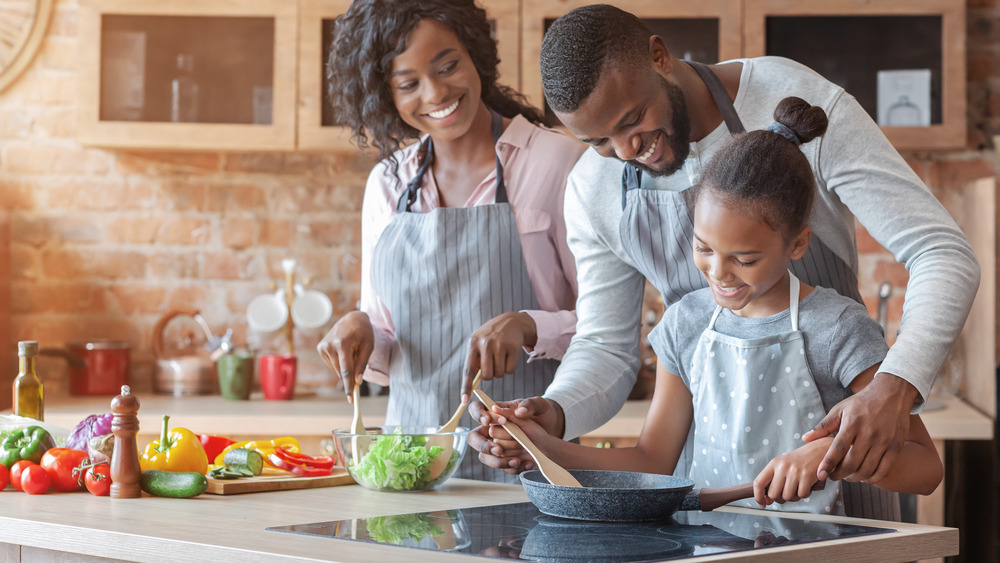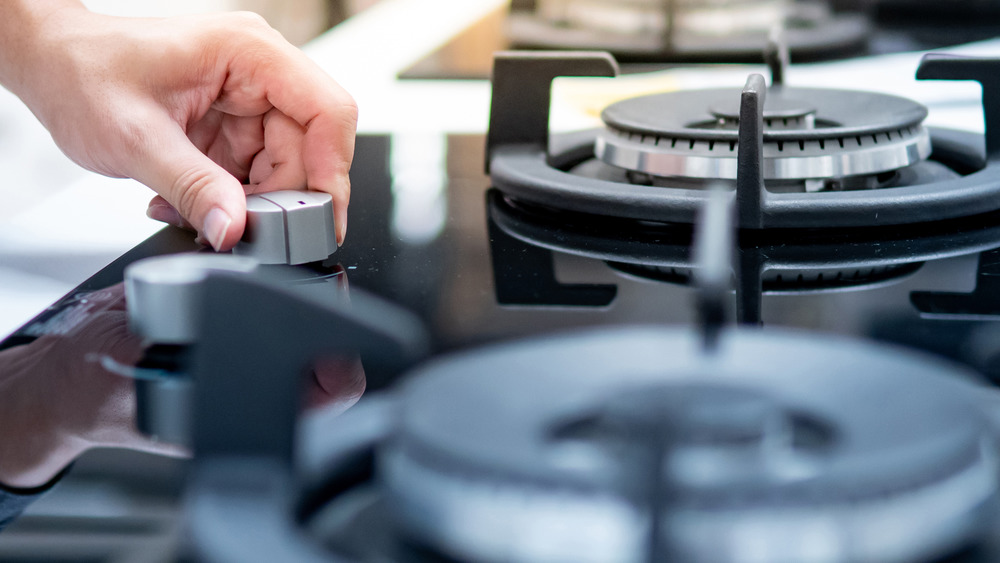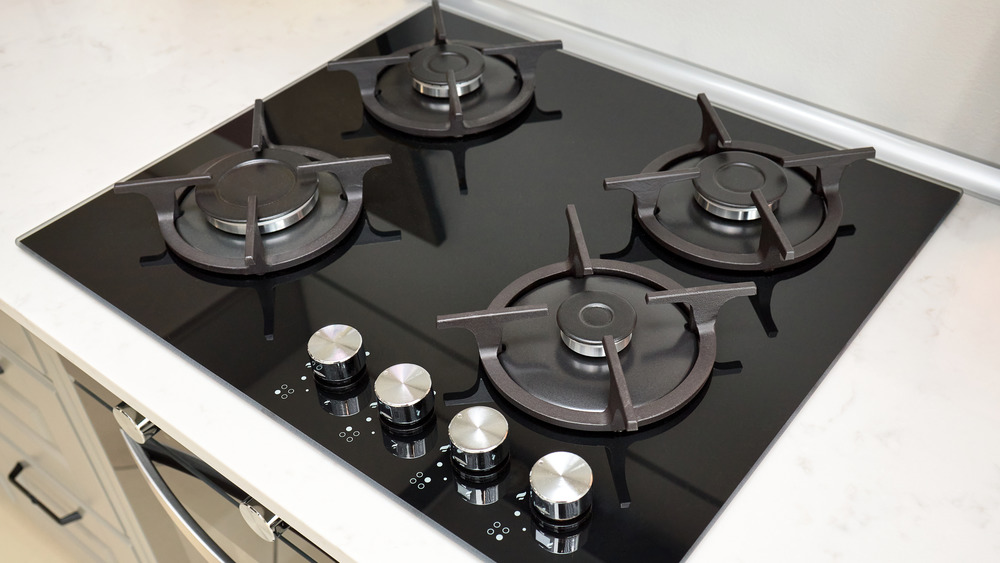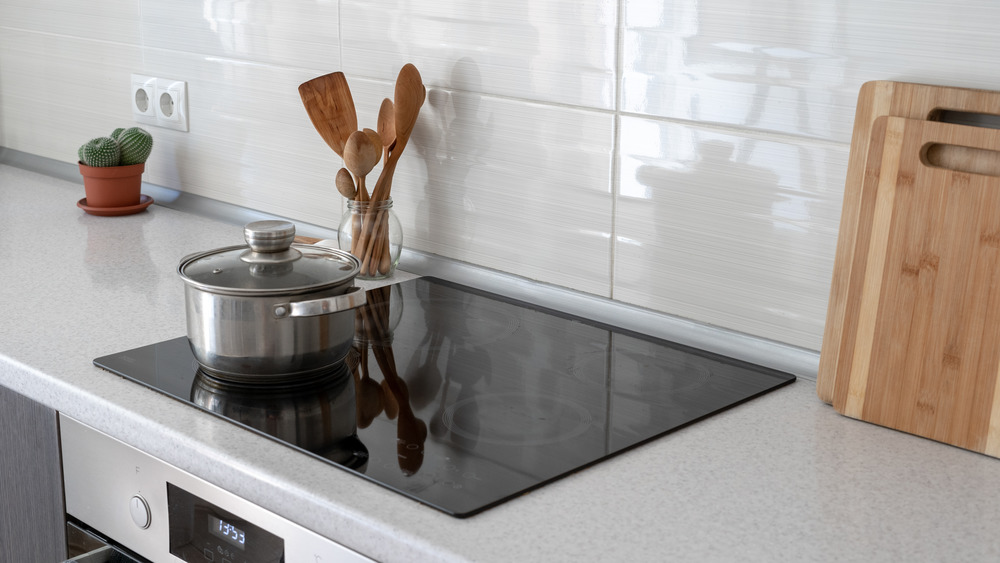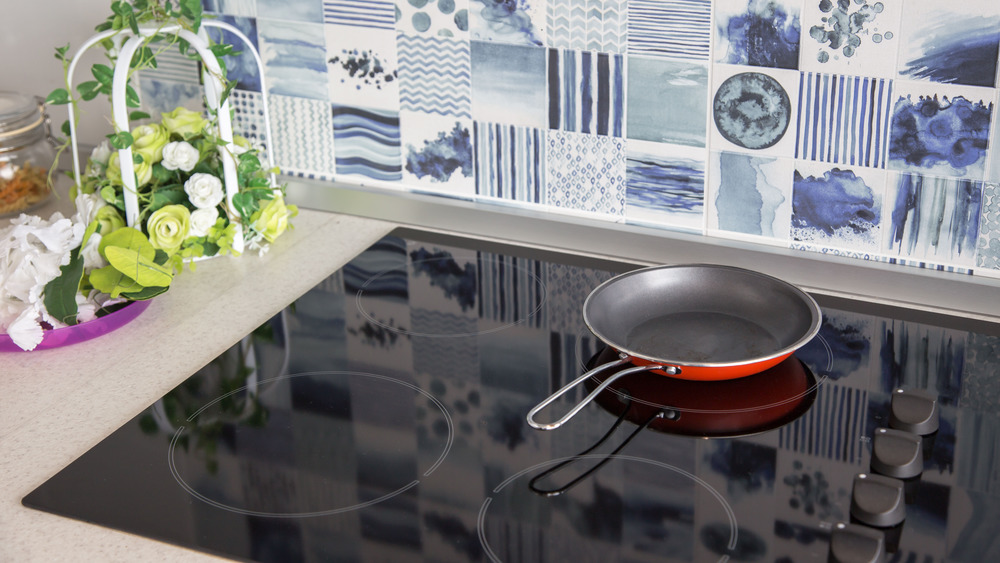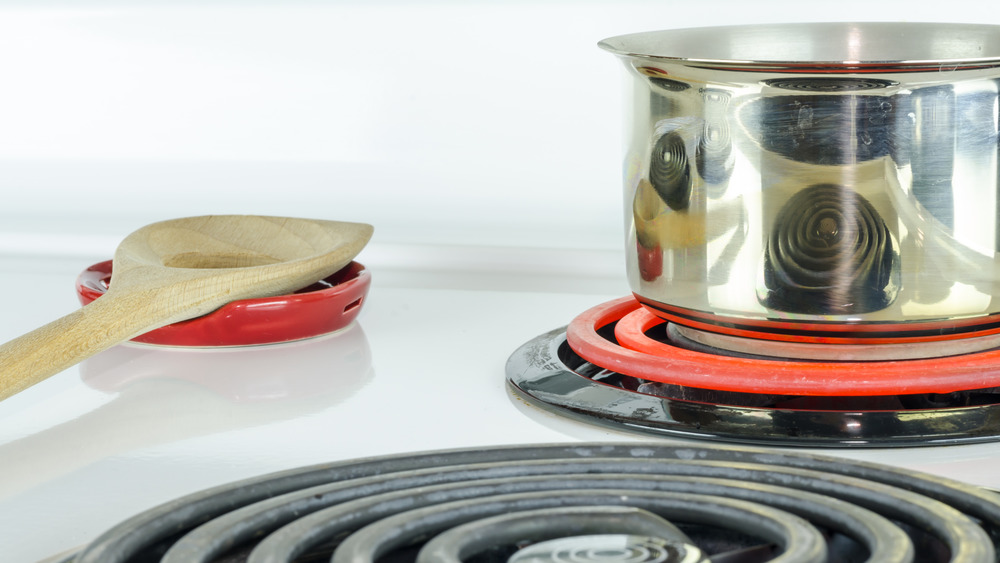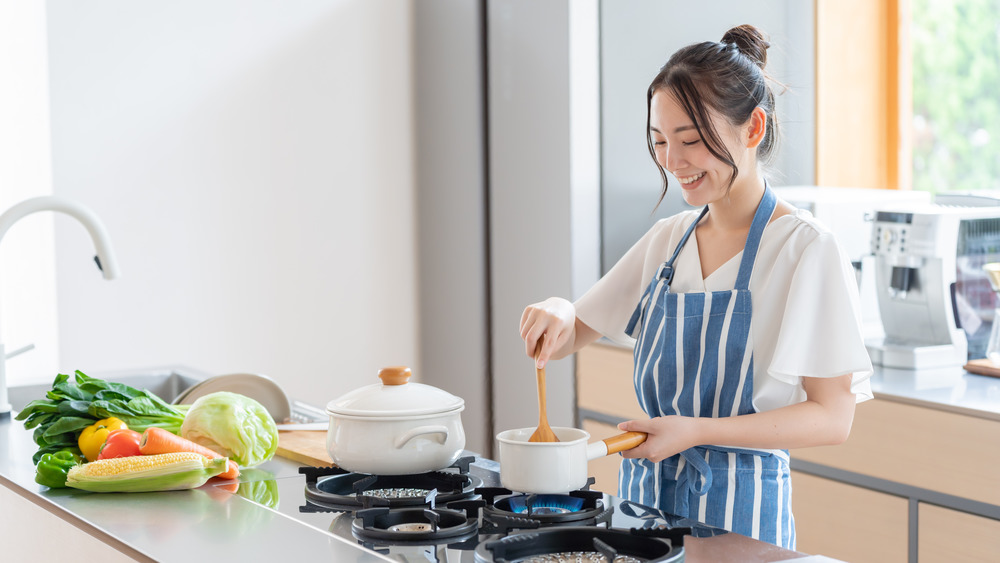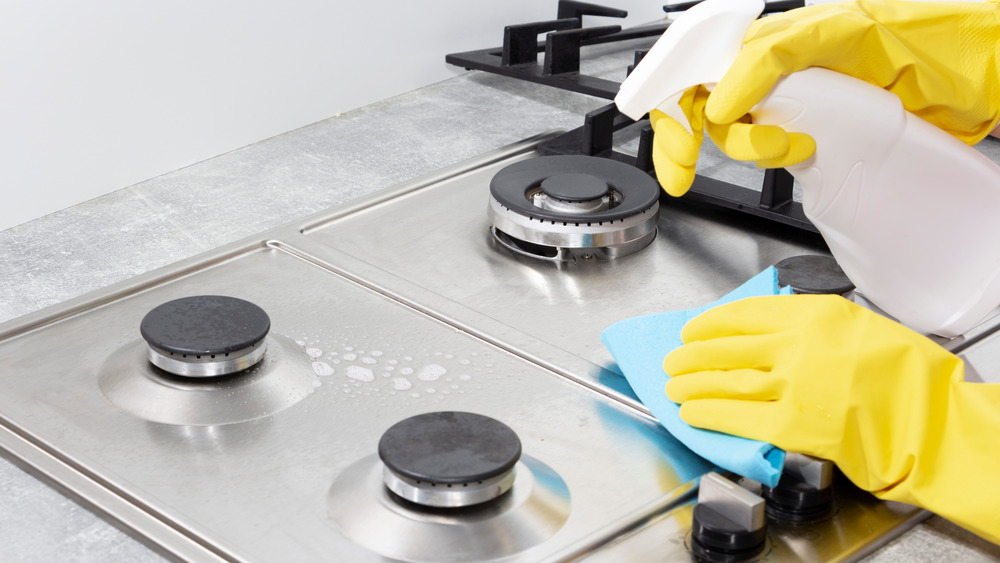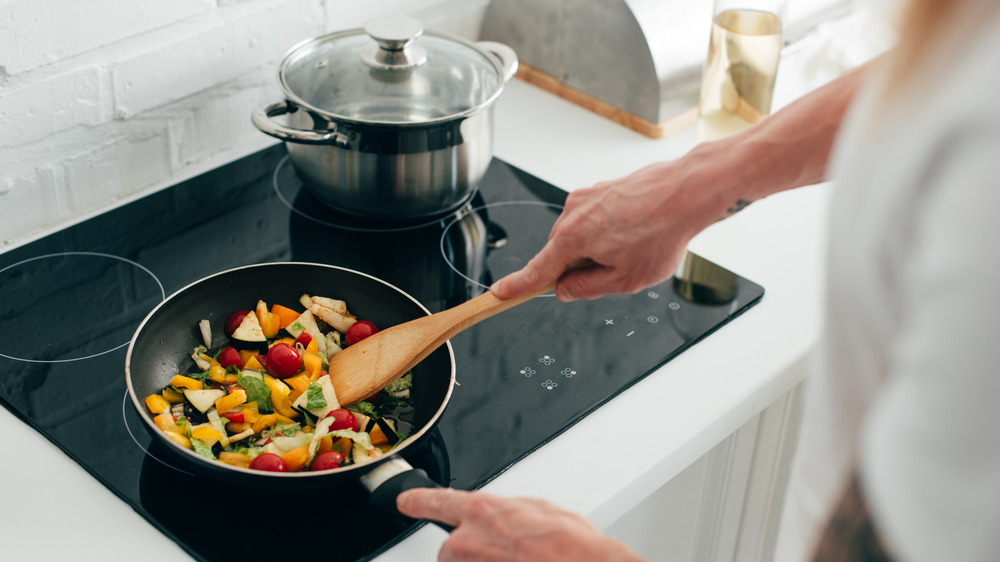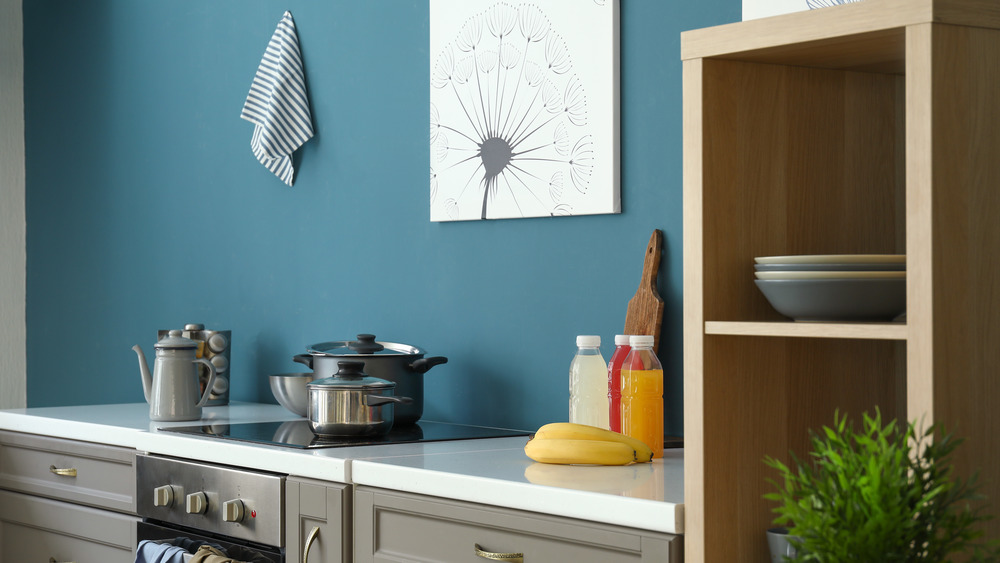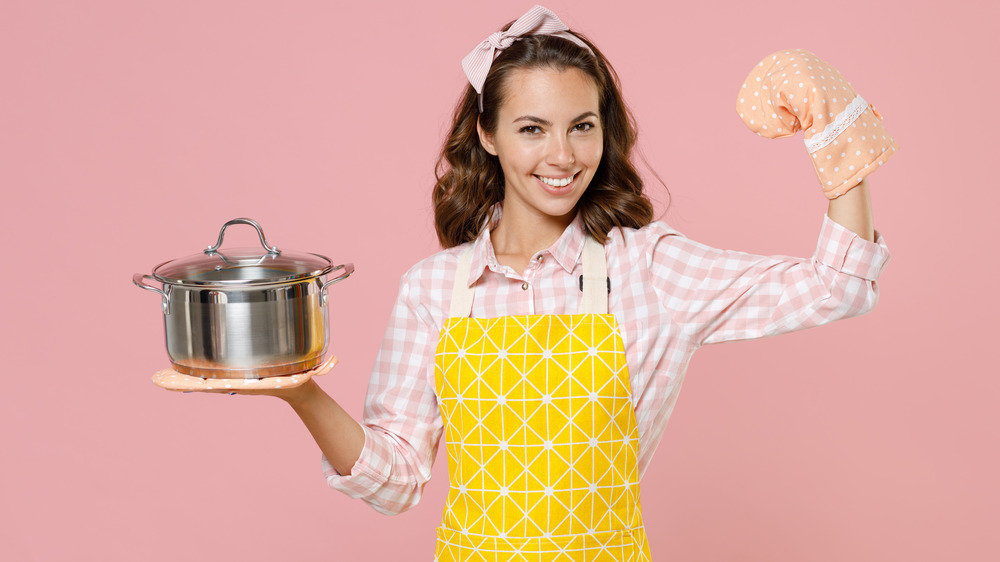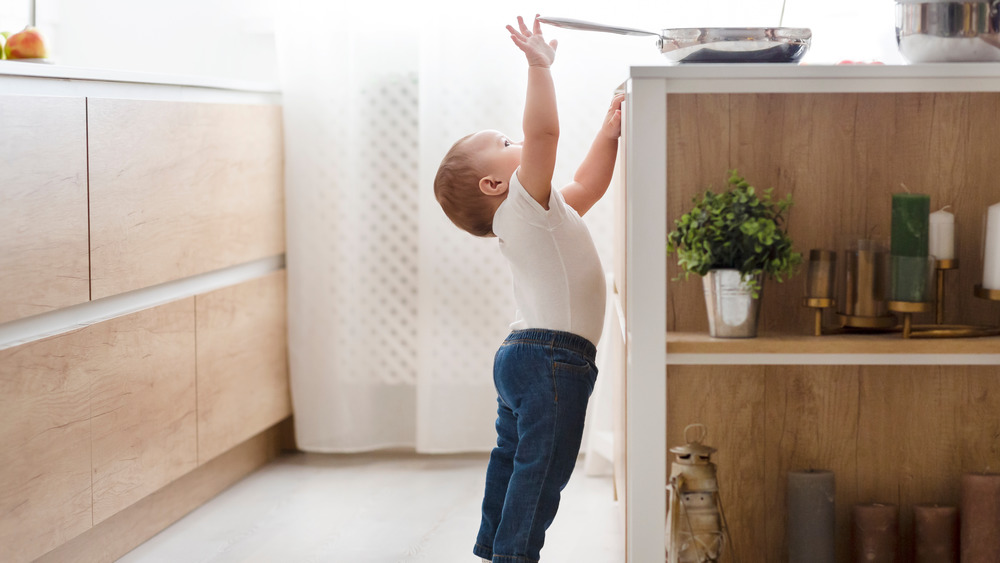You've Been Using Your Stove All Wrong
The stove is not only a kitchen staple, but it's truly what makes a kitchen complete. From the moment we're old enough to make our own grilled cheese or to heat up some soup for ourselves, the stovetop becomes a significant part of many of our lives. And who can forget first graduating into make-your-own-hot-dog-and-hamburgers territory and how excited and grown up it made them feel?
Considering all the special birthday cakes, anniversary treats, and holiday meals you've made in your kitchen, you must know your stove pretty well, right? You know which burner is your favorite (and we all have a favorite), and you don't even have to look at the controls to turn it on anymore. But is there a possibility you may be too familiar with your stove? Believe it or not, you may have fallen into a habit of using your stove the wrong way this whole time, and it could be costing you.
From using the right pots for the right burner to the health risks of burning a stove the wrong way, it's important to know what you're dealing with when cooking your next meal. Let's talk about what you're doing wrong with your stove — and how you can make cooking on the stovetop easier and safer.
You're not changing the heat levels on your stove
When turning on the stove to make dinner, do you always turn the knob to the same dial setting? If so, you could be making a cooking mistake that's costing you time and energy in the kitchen.
According to Balanced Kitchen knowing what heat settings to use and when will help your dishes come out even more perfect while making your cooking time much more efficient. Different stove dials have different labels, but there's usually four settings: low, medium, medium-high and high. When you're letting something simmer, which is the term for gently cooking at or below boiling point, that's when you want to turn your burner to low. Medium heat is a little hotter of course, and it's the temperature you want when you're doing something with a lighter touch, like softening vegetables for mashing.
Medium-high, which is actually at the middle of the temperature scale on most dials, is for general cooking, including browning, frying, and sautéing. It's hot, but not hot enough to immediately burn the oil you're using. And finally, high is for when you want to bring something to a boil.
You don't know the different uses for each stove burner
It's normal for a cook to have a favorite burner, but if you stick to your favorite while ignoring the others, you're not getting the most out of your stovetop.
According to Mental Floss, each one of your stove's burners has a different use. Your biggest stove burner is designed for high-powered cooking like bringing things to a boil quickly and searing meat. It's the burner you should use if you need some serious heat, and this is why it's appropriately called the "power burner."
The medium-sized burners on your stove are the all-purpose burners you should be using for most of your cooking. The smaller burner on your stove is called the "simmer burner," and it's the one that should be used for — you guessed it — simmering. It's also the one that's good for warming things at a low, constant heat: think of it as your chocolate-melting burner.
Knowing which burner to use when cooking is also a safety issue. Stovetops are usually set up with the smallest burner in the back and the largest burner in front. That's so you can put something on simmer in the back while you tend to what needs more attention in the front. This minimizes the chances of brushing your arm against something that's simmering and prevents the need to reach over something that's flaming — or splattering — hot.
You're using small cookware on the wrong stove burner
If you're cooking with a wide, round pan, it makes sense to put it on a larger burner for even heating. But when it comes to smaller pans, the rules change.
According to Cook's Illustrated, it's not a matter of using the smallest burner for the smallest pan, but of what exactly you're cooking. If you're bringing something to a boil, like water or soup, Cook's Illustrated reports that it's much quicker — by about five minutes to be exact — to use a large burner. If you're cooking or searing something small in a small skillet, such as a fried egg or a grilled cheese sandwich, the magazine's own experiments found that it's more effective to use the smaller burner. This is because a larger burner directs its flames outward, and so, a small cooking task on a large pan could direct the flames away from the food in the center. On the other hand, a liquid in a small pan could be boiled faster, since the flames will wrap around the bottom of the pan.
To sum it up, the heat of a larger burner might not distribute across the bottom of a pan evenly, so a small skillet on a small burner could result in a more even sear. Heat distribution doesn't matter as much for something like soup or water, but keeping this in mind will definitely help make your grilled cheeses the bomb.
You don't have the right pans for your induction stove
If you're in the market for a new stove, you might be tempted by an induction cooktop. There's a lot of benefits to them, including faster heat and more accurate temperature control. But according to Good Housekeeping, there's a catch with induction cooktops: you'll need to have the right cookware and learn exactly how to use it.
Pots and pans used for induction cooktops not only have to be capable of activating the stove's heating element, but pots that are smaller than an induction burner won't always catch enough heat. And if you place these pots even slightly off-center or lift your pan, you might lose cooking power, Good Housekeeping reports. Induction stovetops are also easy to scratch, so those old hand-me-down pans might not be useful, even if they are induction-friendly.
And here's a big caveat for international foodies: you might have to forget your wok or other curved cooking pan. If you love whipping up a classic Asian stifry in your wok, you might want to rethink the idea of induction altogether. According to Harts of Stur, the curved bottom of a wok won't provide enough contact with this kind of cooktop, and neither will any other pan with a curved or dented bottom. Bottom line? If you're not using pots and pans with completely flat bottoms on your induction stove burners, you're making things much more difficult for yourself.
You're not using your electric stove burners correctly
There's some serious advantages to an electric stove, including that most of the heat is transferred directly onto the pan, and there's minimal energy loss. But according to Fine Cooking, that comes with a catch: it's difficult to control the heat from an electric stove. But there are some ways to work around the issue.
The heating elements in an electric stove respond very slowly when you turn the heat up or down, and this can ruin a dish. Ever turn the heat down beneath a skillet to find you burned the bottom of the pan anyway? You're definitely not the first or the last. And this is where you'll need to get a little creative and use more than one burner for your dish.
A simple pot of rice shows one example of how to do this, since it's something you want to bring to a boil and then simmer for a while. The trick is to use one burner on high to get your pot boiling and, at the same time, have another burner preheating to the lower, simmer-level temperature, according to Fine Cooking. Once you've got your boil going, move your pot to the simmer burner instead of turning down the heat, and you'll avoid those pesky burned dishes.
Your stove isn't properly ventilated
Pollution is probably the last thing you think of when whipping up dinner, but according to Vox, using your gas stove improperly could be putting your health at risk.
Studies have found that we spend about 90 percent of our time inside, and this number has likely risen since it was first recorded in 2001, Vox reports. The amount of time we spend indoors means indoor air quality is a bigger concern than we might assume. In fact, the indoor air of a typical home might contain as many as 100 times the pollutants as the air outdoors. A big source of that pollution is gas stoves.
And it gets worse: research suggests that gas stoves can cause a level of air pollution that, if it were outdoors, would be breaking some major laws, Vox found. Here's where it gets weird. They also say that while gas stoves technically don't have to be vented outdoors, they absolutely should.
According to The Guardian, that's just not enough. In fact, they go as far as recommending that gas stoves be replaced by electric stoves altogether. If that's not possible, they say outdoor ventilation, exhaust hoods, open windows, air purifiers with a HEPA filter, and carbon monoxide detectors should all be used in homes with gas stoves as well. These additions could get rid of some of the carbon monoxide, nitrogen dioxide, and other potentially dangerous gases released by your stove.
You're not cleaning your stove properly
Cleaning your stovetop is one of those things that's easy to overlook, especially if the mess is not the kind you can just wipe off. But while cleaning electric and gas burners is a pain, according to AJ Madison, going too long without cleaning them is a major mistake — and not for the reason you might think.
The biggest danger from a dirty stovetop comes from the fact that it's a major fire hazard. When food, and particularly grease, splatters and is left to build up on and around stovetop burners, it's only a matter of time before something catches on fire, AJ Madison says. While it's not necessary to deep clean your stove every day, if you're not sure when you've done it last, it's been too long.
To clean your stove thoroughly, you'll want to disassemble all the parts that you can, clean thoroughly with hot, soapy water, and wipe down the rest. You should also be familiar with the pattern of holes in your gas stove burners. Check them regularly to make sure they're not getting clogged, and if they are, use a pin to clear out obstructions before you use them again.
You're not preheating your electric stove burners
We all know there's not enough hours in the day, and to be honest, and trying to save time when and wherever we can is basically a way of life. On that note, here's a question: when you're cooking on your electric stove, do you put the pan on the burner, turn the stove on, and then start cooking?
You might feel like you're saving time, but according to Self, preheating burners is an invaluable step if you're cooking with an electric stove. Why? Because elective stovetop burners take a surprisingly long time to heat up — as much as 15 minutes, to be exact. Fortunately, there's an easy solution: just turn your electric burners on while you're prepping, and by the time you're ready to cook, they should have reached the desired temperature.
That brings up another question: should you be preheating your skillets and pans, too? Taste of Home says that the answer is "sometimes." If you're searing meat, toasting nuts or spices, sautéing vegetables or frying eggs, definitely preheat your skillet as well as your burners. For garlic and mushrooms, which you might want to avoid drying, preheating the pan isn't necessary.
Your stove could be a fire hazard
Stoves are in pretty much every kitchen across the country, and given how common they are, it's easy to forget that they're a massive fire hazard. Cooking fires are actually the "number one cause of home fires and home inujuries," says the National Fire Protection Association (NFPA).
Let's talk about some of the things you're doing with your stove that are increasing the risk of fire or injury. The NFPA says that the most common cause of kitchen fires is leaving something cooking on the stovetop unattended. It's easy to do, with the phone ringing in the other room, the dog having to go out and your kids needing you to start up Netflix. Plus, you'll only be away from the stove for a second. But according to the NFPA, that second can be life-changing.
To keep everyone safe, the NFPA advises never leaving the kitchen if you've going something boiling, frying or grilling on the stove. And if you've got something simmering or in the oven, the organization recommends setting a timer to remind yourself to check on it regularly. The NFPA also notes it's important to make sure you're not leaving utensils, towels, pot holders or packaging near the stove, and around open flames, and you'll want to avoid hanging those things on the walls around it.
You're using damp cloth on the stove
It's a super easy thing to do: you're juggling a few different things on the stove, you realize that something has to be moved right now, and you grab the closest thing in reach to protect your hands from the handle. According to the Iowa State University AnswerLine, this habit might mean you're asking for a burn.
The AnswerLine has a few recommendations on how you can be safer in the kitchen, starting with using oven mitts or a potholder to move something hot on the stove or from the oven. That's not the job a towel was meant to do, so make sure you have the proper tools for the job.
Also, AnswerLine recommends you should never use wet potholers or oven mitts, even if they're just a little damp. If you were to reach for something super hot with a damp oven mitt, for example, the moisture in the mitt is going to heat — and quickly — and this could cause some serious scalding. In fact, don't even keep these cloth helpers in the kitchen when they're wet. Just throw them in the laundry, where they're well out of reach and you can't accidently grab them.
You're not properly positioning your pans on the stove
How do you position your pots and pans when cooking on the stovetop? Chances are they're at an angle that makes it convenient to quickly grab their handles. And that might mean you're not doing what fire safety experts say you should be.
Michigan's Mundy Township Fire Department advises that the handles of pots and pans on the stove should always be positioned inward and not over an open flame or another burner that's still hot. That's because a handle that's convenient to grab is also one that's convenient to bump into and cause a burn or spill. Plus, those with children know how fast those little critters can be, and a pan handle sticking out over the top of the stove can be incredibly tempting to a child passing through the kitchen.
The Chef Marshall O'Brien Group goes one step further and suggests that whenever you have the opportunity, you should use the back burners first. This will keep a potential tragedy far back from the edge of the stove, the floor, and the delicate skin of all those in your home. A safe kitchen is a happy kitchen, after all!
